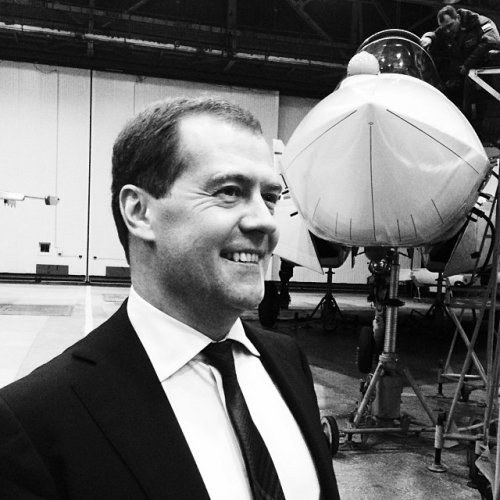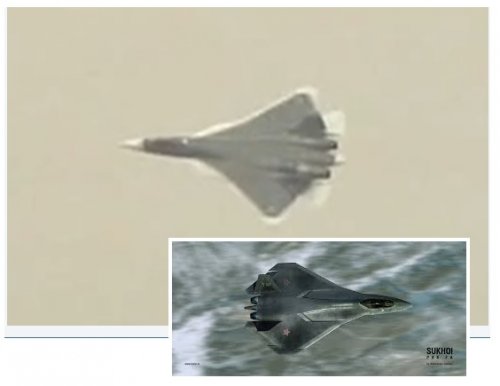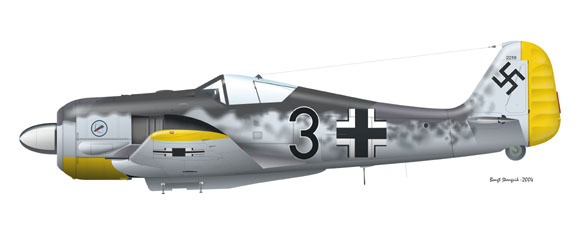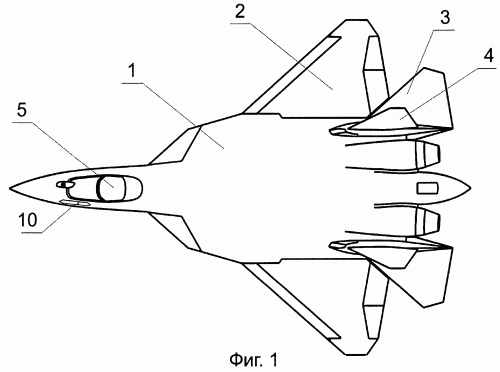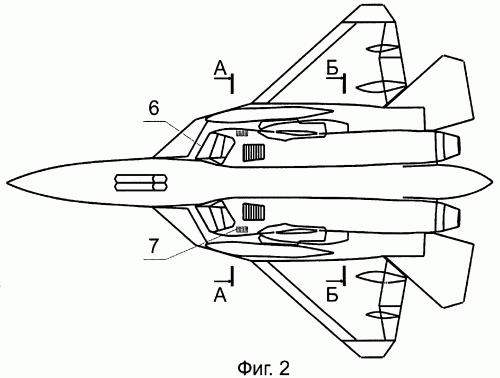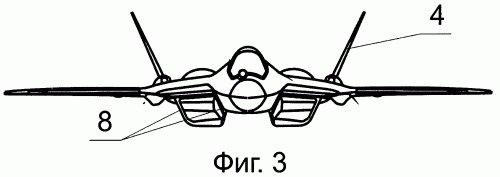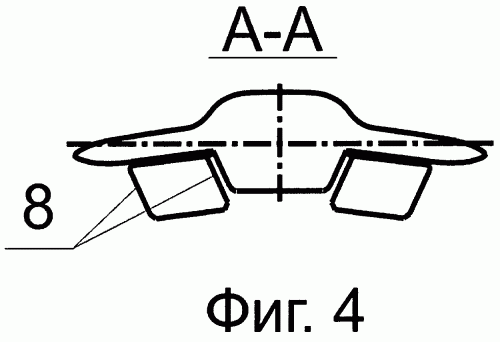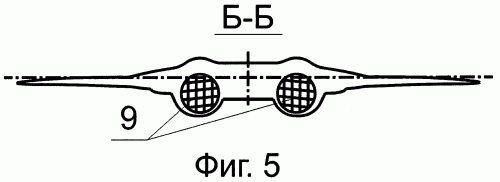The invention relates to the field of aeronautical engineering, namely to control complex information systems executive avionics general aircraft equipment, aircraft and information display systems from the external environment, as well as their condition. Technical result - enhanced functionality, reducing the pilot and data downloading, respectively, increase the effectiveness of multi-purpose aircraft. Integration of on-board equipment (CCD) is provided by forming a part of the sighting and navigation system integrated electronic systems, integrated electro-optical system, an integrated set of communication tools, hardware integration of the radar system (radar) systems, electronic intelligence and electronic warfare (SRTR / RAP), complete sets of IFF (Kago) and connected stations (PC) on the basis of sharing the type of active antennas, phased array (AESA) and functional integration of these systems in computational logic blocks BTSVS control. Extension tasks MIS is provided by the introduction of the computational logic blocks BTSVS.
The invention relates to the field of aeronautical engineering, namely to control complex information systems executive avionics equipment, aircraft and information display systems from the external environment, as well as their condition.
Known technical solution relating to the field of aviation (RU № 2231478), in which a general aircraft equipment, engine and means of mechanization of multi-purpose aircraft, the system display and controls, a set of weapons and passive countermeasures, system monitoring and recording parameters, the system interairplane communication system, communication with control centers, radar sighting system, flight control and navigation system, thermal sighting system, laser optical sighting system, the countermeasures, the control means of destruction and passive countermeasures remote guidance system, satellite navigation and guidance systems, display processor, reprogrammable memory device, and multifunction indicators, unit conversion of television signals, onboard digital computer are interconnected by information exchange channel. In a digital computer computational logic modules operational planning of the flight task, decision-making equipment failures, input-output-control information exchange and integrated target allocation and targeting, efficient selection and use of weapons and combat are interconnected via an internal information sharing. Additionally introduced parameters meter movement radar antenna aiming system and radar image synthesizing unit, as well as computational logic modules emergency operational analysis of the results of exploration and use of lethal force, ground training simulators and crew, combined targeting Aeronautical map formation parameters aircraft emergency escape members crew formation motion parameters radar antenna sighting systems provide a significant expansion of functionality and efficiency of the use of multi-purpose aircraft in a single battle and a double battle and combat training performance.
Known management information system (MIS) of the aircraft (RU № 2392586) containing information-control field (FTI), the onboard digital computer system (BTSVS), input-output unit and exchange control, block formation flight and navigation parameters database flight mission. In addition, the system comprises a hub signal generating unit and integration of data for display and reception of control actions, control and monitoring unit aircraft equipment, electronic control unit resistance, providing a low-altitude flight block, block group piloting software, recording control section of the means of objective control and a control mode.
The closest analogue is the sighting and navigation system multi-purpose aircraft, comprising interconnection via information exchange systems (CIMO) with onboard digital computer system (BTSVS)
- A set of navigation equipment (KPNO)
- Set of different radio wavebands (PC),
- Equipment satellite channel (SCS)
- Communications equipment with control points (SPU)
- Aviation Terminal (AT) combined navigation system and data exchange
- Set of IFF equipment (Kago)
- A set of multifunctional indicators, panels and display on the windshield,
- Complete overview and sighting means comprising:
- Radar System (RLS)
- Thermal imaging system (TPVS)
- Optical location system (OLS)
- A set of countermeasures including:
- System of electronic intelligence and electronic countermeasures (SRTR / REP)
- Optoelectronic intelligence system (SOER)
- Resource Management lesions (susp)
- Device for emission detection REP (HC)
- Control and recording system, including video recording parameters (LCCS)
- Operational controls (TOC)
- general aircraft equipment (CCA)
- A set of aircraft weapons (PCB) (RU № 2276328).
As disadvantages of the prototype are the following;
- Lack of hardware and functional integration of systems based on common physical principles leads to underutilization of the technical capabilities of systems, duplication of equipment and increase in weight of the equipment;
- In the absence of computational logic modules BTSVS complex information processing systems from AK reduces the reliability of identification, tracking, recognition, and state identification purposes identified various surveillance and targeting system;
- In the absence of computational logic modules BTSVS forming units complex data to indicate the formation of teams and tactical management for scheduling control actions of computational modules and operational controls to information systems executive increases the load of the pilot;
- The lack of information coming over analogue lines, whereby blocks from the computer system of the complex have incomplete information about the state of;
- Air terminal equipment no unified system of navigation and data exchange reduces immunity and secrecy of communication channels, the possibility of using complex deprives its information for problems integrated IFF purposes, as well as with respect to aircraft navigation group and ground control;
- The lack of built-in display means display processor designed for other computing tasks, but to form a display, and associated equipment vital LA autonomous channel information exchange makes the complex actually unusable in case of failure of the central computer system of the complex;
- The lack of 3D warning and voice command control system, allowing the pilot to reduce information load and boot from the Manual Control of the CCD;
- The absence in the BWC managed device reduces the level of reflections from the radar antenna probing signals and external sources, thereby reducing the level of the effective reflecting surface of the aircraft as a whole.
Technical result, The aim of the invention is to enhance the functionality, reducing the pilot and data downloading, respectively, increase the effectiveness of multi-purpose aircraft.
Said technical result is achieved that in an integrated complex avionics multifunctional aircraft containing interconnection via information exchange systems (CIMO) with onboard digital computer system (BTSVS)
- A set of navigation equipment (KPNO)
- Set of different radio wavebands (PC),
- Equipment satellite channel (SCS)
- Communications equipment with control points (SPU)
- Aviation Terminal (AT) combined navigation system and data exchange
- Set of IFF equipment (Kago)
- A set of multifunctional indicators, panels and display in the cockpit,
- Complete overview and sighting means comprising:
- Radar System (RLS)
- Thermal imaging system (TPVS)
- Optical location system (OLS)
- A set of countermeasures including:
- System of electronic intelligence and electronic countermeasures (SRTR / REP)
- Optoelectronic intelligence system (SOER)
- Resource Management lesions (SU SP)
- Device for emission detection (HC)
- Control and recording system, including video recording parameters (LCCS)
- Operational controls (TOC)
- General Aircraft equipment (CCA)
- A set of aircraft weapons (PCB)
- A set of multifunctional indicators, panels and display on the windshield, combined in the information control field, unit conversions television signals, external storage units and hubs signal interconnection via information exchange systems (CIMO) with BTSVS form information management system,
- RTR system / REP, radar, Kago hardware integrated into radio systems (IRTS) by connecting the input of the receiver and the transmitter output systems RTR / REP and Kago to the exit-entry active phased array (AESA) radar, and input-output systems RTR / REP , radar, Kago connected on the internal channel of information exchange (Kior) to the input-output radio system calculator (VRTS), computational logic blocks which: input-output and control information exchange, support and recognition of the detected objects, interaction management systems RTR / REP , radar, Kago within autonomous system tasks and objectives of the calculator BTSVS, interconnected by an internal information exchange channel (VKIO)
- TPVS, RL SOER integrated into opto-electronic system - (IOES) by connecting their inputs and outputs to the calculator on CIMO optoelectronic system (VOES), computational logic blocks which: input-output and control information exchange, maintenance, breeding and recognition of the detected objects, interaction management TPVS, RL SOER within autonomous system tasks set calculator MIS interconnected by internal information exchange channel optical systems (KIOO)
- Set of different radio wavebands (PC), a hardware-integrated system with antennas RTR / REP by connecting the output to the input channels PC transmit antenna system RTR / REP, equipment satellite channel (SCS), communication equipment with control points (SDA) and Aviation terminal joint navigation system and integrated data exchange in complex communications (Xs) by connecting their inputs and outputs on the internal channel of information exchange complex communications (KIOKS) to the calculator Xs - (VIKSS) computational logic blocks which: IO and control communications between the aircraft and the control points and telecode voice messaging, automatic selection of the communication channel when a hardware failure and the impact of interference on the internal channel interconnected VIKSS and functionally integrated into the avionics equipment (CCD) by connecting the inputs and outputs VOES calculators, and VRTS VIKSS on CIMO to the inputs-outputs BTSVS, computational logic blocks which: IO-control information exchange, operational flight mission planning, formation flight and navigation options, providing piloting group, integrated fusion of tracking of targets according to all information systems, integrated air target recognition , integrated IFF purposes, generating data to indicate integration algorithmically generated control actions and the operational controls, automatic target allocation and targeting systems, electronic warfare management, operational choice and use of lethal force, the UNCCD and general aircraft control equipment and power plant, providing a low-altitude flight write control of the means of objective control, integrated systems management regimes CCD (IRTS, IOES, Xs, susp) general aircraft equipment and aircraft are interconnected by VKIO, and she BTSVS with interconnected by CIMO information control field, including a set of indicators and multifunction indicator on windshield, unit conversion of television signals, an external storage device and blocks Hub signals (n units) forms a management information system.
In addition, the inputs and outputs of multifunctional indicators information and control field (FTI) having built display processors can be interconnected redundant channel information exchange (cutting) with blocks concentration signals (BCS), KPNO, VIKSS, integrated control system (CCS) that in case of failure BTSVS allows you to organize the backup communication channel in the FTI, and extract the manual commands crew. At the same time the formation of a complete display and backup software manual or automated control systems KPNO and CIL in the minimum volume required to return to the airfield and landing assume multifunctional displays FTI.
The complex may be provided with the introduction of the computational logic blocks BTSVS unit integrated IFF (CLC), solves the problem of data integration from IFF/Kago and AT using additional features of the type of target from the radar and from RTR / REP.
The complex may be provided with the introduction of the CCD TV camera (TCE) front view, displaying the situation before the aircraft and aviation collimating indicator (CAI), which is part of the FTI, which are related digital channels transmit TV signals from the interface device frame (UCSC), combining Images of these devices and the TV channel control of outer space (TVKVP) issuing a single image on LCCS.
The complex may be provided with a controlled frequency-selectable screen (UCHSE) connected to the transmission line single commands, part of the CIMO with BTSVS, and providing for its operation teams with energy absorption of radio waves from external sources that fall under the nose cone of the aircraft.
The complex may be provided with the introduction of the computational logic blocks BTSVS block voice command system (RCS) control that recognizes voice commands and queries pilot coming in digital form from the Xs and issuing them to the appropriate computational logic blocks BTSVS directly control systems BWC .
The complex may be provided in a composition of the introduced Xs Alert 3D system (3DCO), which receives signals from BTSVS obtained from spatially distributed sensors on the aircraft systems and CCD.
Integration of the CCD is provided by forming a part of the sighting and navigation system integrated electronic systems, integrated electro-optical system, an integrated set of communication tools, hardware integration of the radar system (radar) systems, electronic intelligence and electronic warfare (SRTR / RAP), a set of hardware IFF (Kago) and connected stations (PC) on the basis of sharing the type of active antennas, phased array (AESA) and functional integration of these systems in computational logic blocks BTSVS control.
Extension tasks MIS is provided by the introduction of the computational logic blocks BTSVS, such as:
- Unit complex for fusion of target tracking;
- Unit complex target recognition according to flight mission, the information of the radar system (radar), electronic intelligence (RTR), optical-location system (OLS);
- Unit complex identification information set by IFF equipment and aviation terminal navigation and data exchange in the light of the type of target recognition;
- Control unit integrated systems Xs, IRTS, IOES;
- Block the formation of tactical management teams.
Backup circuit and control the CCD and CCA LA ensured by introducing additional constraints vital systems: navigation equipment, communications, lights and integrated management system with FTI objectives besides providing solution display, the minimum required amount of CCD systems management tasks to complete flight failure calculator IUS.
The invention is illustrated by a drawing, which shows a block diagram of an integrated on-board equipment (CCD) multi-purpose aircraft, which comprises:
1 - an integrated set of communication facilities (Xs) comprising:
various radio wavebands (PC) 4 - provide speech and exchange of information between tactical aircraft in the performance of the group flight, communication equipment with control points (STC) 3 - provides a link for ground and air command and control points and guiding voice and messaging telecode, satellite equipment communication channel (SCS) 2 - provides long distance communications with ground and air command and control points and guidance via satellite, aviation terminal (AT) 5 combined navigation and data exchange - enables communication between the aircraft and the control point navigation and tactical information related to information exchange channel complex communications (KIOKS) 7 6 VKSS calculator, manage channel selection exchange in case of failure of equipment and impact noise, using the system's antennas RTR / REP 17 teams on board digital computing system - BTSVS 33, as well as the relative navigation of the aircraft and IFF subscribers;
8 - operational controls (TOC) on the handle control plane (RUS) in roll and pitch and thrust lever (throttle). Directional control pedal. On RUS automation control buttons, joystick trim longitudinal and lateral control, joystick control marker purpose combat missile launch button and firing the main gun. On the throttle control buttons mounted airbrake and drogue parachute;
9 - ejection device (HC) money spent REP comprises means passive countermeasures: false thermal targets and chaff radar radiation. The device is controlled by CIMO 52 teams formed computational logic control unit electronic countermeasures (SEC) 35;
10 - Management System means of destruction (SU SP) is designed to:
- Issuing commands to the preparation and launch of specific tools from the available set of weapons (PCB) 14 to specify a priori PATTERN preparation and launch, coming from input-output suspension 10 through 52 CIMO in interacting systems and PCB 14;
- Receive response signals from the PCB 14 on the preparation, launch readiness, start fact,
11 - general aircraft equipment (CCA) system includes: electricity, fuel, fire, air, hydraulic or pneumatic, and emergency evacuation of the aircraft crew, lighting and oxygen equipment, equipment related to pilot CIMO 52 blocks concentration signals (BCS) and 32 BTSVS 33;
12 - set of navigation equipment (KPNO) provides for the formation parameters of the aircraft relative to the earth's surface, defined intermediate waypoints and other aircraft in the group (fix, track components and air speed, angle of attack and sliding components of the angular velocity of the aircraft, component of the acceleration of the axes of the aircraft), which comes through in the CIMO 52 BTSVS 33 in computational logic block formation flight and navigation parameters (FPNP) 43, to implement the decisions flight and navigation problems and the formation parameters of control signals in interacting systems;
13 - System monitoring and recording parameters (LCCS), interacting by CIMO 52 and backing loop information exchange (cutting) 55 with all onboard equipment. Implements mode embedded control and reception of control parameters on-board systems. Writing in the current time control results in the form of parametric and video information to the relevant information carriers, which are analyzed in ground units after the flight;
14 - set of weapons (PCB) contains: Shooting cannons, guided and unguided weapons class "air" and "air-surface". With the TV-out PCB 14 frames of television pictures (in the form of a television signal) of weapons with television homing through communications television signals (COTS) 53 is input to the unit conversion of television signals (BPTS) 29 to indicate the pilot and 13 for LCCS recording;
15 - Integrated Management System (SIC), comprising the aircraft control system and remote control system, stop limiting regimes of flight system and cross-directional control. Management system toed wing. Actuators control system;
16 - Integrated radio system (IRTS) comprising:
- System of electronic intelligence and electronic countermeasures (RTR / RAP) 17, which provides for detection, measurement parameters and the degree of danger, as well as tracking of air and ground radio-emitting purposes issuing the information received in BTSVS 33 and posing as jamming through its antenna and through the active phased array (AESA) radar system (RLS) 18. Thus management AESA radar carried 18 calculator radio system (VRTS) 19 Command BTSVS 33 from the control unit integrated systems CCD (UISKBO) 47;
- Multifunction radar system (radar) 18, which provides for detection, measurement coordinate air and ground radio-goals, mapping the Earth's surface and other functions, the set of which may vary. Modes "air-surface" radar 18 is provided with a TV output, from which 18 received radar radar COTS footage through 53 are transmitted to the TV input BPTS 29 for display. In this direct control radar modes 18 VRTS carried 19 to 33 teams BTSVS UISKBO block of 47;
- IFF (Kago) 20, which provides the systems and air traffic control radar identification of nationality as using autonomous antennas and antenna through RTR / REP. Thus management Kago 20 can be carried out from the calculator VRTS 19, and from 33 BTSVS last priority;
- Calculator (VRTS) 19 providing both teams BTSVS 33 and autonomously within the division of tasks between systems MIS 28 and 16 IRTS, the direct management of the components of the inner channel IRTS information exchange Kior 21 and 33 interact with BTSVS CIMO channel 52.
22 - integrated optoelectronic system (IOES) comprising:
- Optical location system (OLS) 23, which provides detection of air targets with optical or thermal contrast, their direction finding and ranging up to them;
- Thermal imaging system (TPVS) 26, which provides for detection of ground targets with optical or thermal contrast, their direction finding and ranging up to them, as well as the guidance system of SD "air-surface";
- A system of electro-optical reconnaissance (SOER) 25, which provides for detection of missile attack;
- Calculator optoelectronic system (VOES) 24, which provides both teams BTSVS 33 and autonomously within the division of tasks between systems MIS 28 and 22 IOES, direct control of the components of the Inland IOES information exchange channel optical systems (KIOO) 27 and interaction with BTSVS 33 CIMO channel 52;
28 - Information Management System (IMS) comprising:
- Unit conversion of television signals (BPTS) 29, which is a device for receiving, switching, conversion and distribution in information-control field (FTI) 30 television signals (images), applied to its inputs, both analog and digital form BTSVS from 33 CCD systems and PCB 14 and 52 connected to the output from CIMO IFM 30 and input / output with BTSVS 33;
- Information and control field (FTI) 30, which is a combination of indicator board-control devices of the aircraft, which include, for example, multi-function displays (MFD), multifunctional control display (IFPI), collimating light aircraft (KAI), remote controls and indicators (ISPs) and connected on 53 CIMO entrance with BPTS 29 and inputs / outputs with BTSVS 33 and 32 BCS;
- External storage device (TSD) 31, which is a device that provides input information via removable media from the ground-based preparation, storage and issuing it in BTSVS 33, documenting the results of MIS 28 for subsequent rapid analysis and connected by CIMO 52 input / yield with BTSVS 33;
- Block signals Hub (BCS) 32, which is a device designed to receive analog and digital signals in accordance with GOST 18977-79 from aircraft systems, teams from government, converting them to a digital format, as well as the reception of signals in digital form issuing them in analog form on actuators and I / O connections on the CIMO 52 BTSVS 33;
- On-board computer system (BTSVS) 33 comprising:
input-output unit and control communications (VVUO) 36 generating unit display and reception of control actions (FVIiPUV) 34, the control unit electronic countermeasures (SEC) 35, block group piloting software (OGSv) 37, the control unit of the means of recording objective control ( UZSOK) 38, a control unit and aircraft control equipment (mowing) 39, a low-altitude flight software block (OMVP) 40, control aircraft (ULA), 41 unit ensure operational use and control arms (OBPiUO) 42, block formation flight and navigation parameters (FPNP) 43, a database of the flight task (BDPZ) 44 generating unit tactical management teams (FKTU) 45, the control modes (BUR) 46, a control unit integrated systems CCD (UISKBO) 47 unit complex fusion support (CHS) 48 unit complex recognition (CR) 49 unit complex IFF (CLC) 50, internal traffic channel (VKIO) 51 BTSVS.
At the same input / output BTSVS 33 is input / output its constituent unit input-output and control communications (VVUO) 36 and the other input / output VVUO 36 is connected to the internal information exchange channel (VKIO) 51, which are also connected to the inputs / O computational logic blocks 34-50, members of the BTSVS 33, and facilitating information exchange between these blocks. Blocks 34-50 are designed as computational logic modules placed on uniprocessor calculators.
Forming unit display and reception of control actions (FVIiPUV) 34 produces forming and delivery by VKIO VVUO 51 through 36 in the 30 FTI by CIMO 52 for displaying information from the CCD systems, general aircraft equipment (CCA) 11, as well as receiving, processing and issuance of other computational logic modules (such as FPNP 43, mowing 39 ULA 41, 46 and other BUR) parameters control actions of the pilot.
Electronic control unit resistance (SEC) 35 provides automatic or automated generation and delivery unit FKTU 45 applications for command and control systems SRTR / REP 17 and its interaction with the radar 18, RL 23 and opto-electronic reconnaissance (SOER) 25 and discharge devices ( HC) 9 in providing electronic protection of the aircraft.
VVUO block 36 is a coupler calculator with links that receive, control and delivery of information.
Block piloting software group (OGSv) 37 provides an implementation group piloting mode using information systems on board to determine the relative location of the aircraft.
Recording control section of the means of objective control (UZSOK) 38 provides delivery to external recording means 13 LCCS exchange parameters of computational logic modules and external systems BWC CIMO 52 and 53 COTS.
Control and monitoring unit general aircraft equipment (mowing) 39 performs analysis of CCA systems and powerplant (SU), as well as automatic and automated management of these systems.
Unit providing low-level flight (OMVP) 40 provides low-level tasks of flight mode (IMP) in the digital terrain map (MSC) with the issuance of the automatic control signals VKIO VVUO 51 through 36 in a comprehensive system of automatic control (SIC) 15 to 52 CIMO.
Control unit aircraft (ULA) 41 provides for the formation parameters for manual and automatic control of director aircraft and engine thrust on information from computational logic blocks such as FPNP 43 OMVP 40, 42 and other OBPiUO VKIO by 51, as well as SIC 15 to 52 CIMO.
Unit to ensure operational use and control arms (OBPiUO) 42 provides a solution to the problem of military use of air weapons (PCB) using 14 units complex fusion support (CSC) 48, forming tactical control (FKTU) 45, a comprehensive recognition (CR) 49, an integrated IFF (CLC) 50 mode control integrated systems (UISKBO) and 47 aircraft (ULA) 41.
Block formation flight and navigation parameters (FPNP) 43 calculates the parameters of the state of the aircraft, including its location, movement and orientation, building flight paths.
Database block flight mission (BDPZ) 44 provides access to the database of the flight task (PP), PP data changes, the control of its integrity, data at the request of the PP units, using them, ensuring synchronization of read-write data PP.
Forming unit tactical management teams (FKTU) 45 provides prioritization of applications run on the use of information systems (IRTS 16 IOES 22 Xs 1) of such computational logic blocks as SEC 35, PSC 48, FVIiPUV 34, based on the information on the tactical situation , the current phase of flight, the basic mode of the CCD, given the flight plan or pilot and according to these priorities skips application block UISKBO 47.
Block mode control (BUR) 46 provides control coordinated operation of other systems on-board equipment of the aircraft and computational logic modules BTSVS 33.
Control unit integrated systems (UISKBO) 47 provides reception from the power control commands FKTU 45 tactical level and the formation of the whole management teams (according to the protocol of information exchange) to transfer them to calculators systems IRTS 16, 22 and IOES Xs 1, as well as receiving response information .
Unit complex fusion support (CHS) 48 on the basis of information systems on the CCD coordinates of the detected targets and their parameters, performs the identification purposes, assigns numbers, builds track their movements and generates a "passport" purposes, containing all the information obtained about them. The "passport" purposes available to all units-consumers using the coordinates and motion parameters of targets (OBPiUO 42 SEC 35, 41 ULA), and special features for the recognition of complex tasks (CR) 49 and IFF (CLC) 50.
Unit complex recognition (CR) 49 solves the problem of complex recognition class and type of the detected targets on the basis of recognition of such systems as SRTR / REP 17 radar 18, RL 23, SOER 25.
Information provided by IMS interconnection within the inner channel of information exchange 51 (VKIO), which is connected to computational logic blocks and BTSVS including VVUO block 36 which other input-output is connected to the CIMO 52.
Traffic channels CIMO 52 KIOKS 7 Kior 21 KIOO 27 are known lines of communication and information exchange, and include mechanical, electromechanical, electrical and natural relationship, exchange of television signals carried by COTS 53.
Communication channel television signals (COTS) 53 - is a set of analog and digital TV signal transmission lines.
Analog and digital communication channels (ADKS) are a set of 54 lines of analog and digital signals.
Inputs and outputs of multifunctional indicators FTI 30 having built-display processors interconnected by information exchange channel (cutting) 55 32 BCS, KPNO 12 VKSS 6, SIC 15, which in the case of failure BTSVS 33 allows you to organize the backup communication channel in the FTI 30 and extract the manual commands the crew. At the same time the formation of a complete display and backup software manual or automated control systems KPNO and CIL in the minimum volume required to return to the airfield and landing assume multifunctional displays FTI 30.
Reserve traffic channel (cutting) 55 is a well-known transmission line and discrete digital signals such as GOST 18977-75.
Introduced in the computational logic blocks BTSVS 33 unit complex IFF (CLC) 50, solves the problem of data integration from gosprinalezhnosti Kago 20 AT 5 and using the additional features of the type of target from the radar and from SRTR 18 / REP 17.
Introduced in the CCD TV camera front view (TCE) 56, showing the situation before the aircraft and KAI, part of FTI 30 associated digital channels transmit TV signals to the interface device frame (ACC) 57, which combines images of these devices and the TV channel control of outer space (TVKVP) 58 outputs a single image on LCCS 13.
Introduced in the controlled frequency-selectable screen (UCHSE) 59 connected to the transmission line single commands, part of the CIMO with BTSVS provides commands for its operation with the absorption of energy from external sources of radio waves that penetrate through the nose cone of the aircraft.
Introduced in the computational logic blocks BTSVS 33 block voice command system (RCS) 60 management recognizes voice commands and queries pilot coming in digital form from the Xs 1, and outputs them to the appropriate computational logic blocks BTSVS 33 directly control systems BWC. In addition, the unit provides speech input data in the CCD system, such as frequency tuning PC 4 and answer questions pilot, for example, reporting on his request, speed, altitude, fuel, and other parameters.
Entered into the system 3D Xs 1 warning (3DCO) 61, of which 33 received BTSVS signals from spatially distributed sensors on the aircraft, colors these signals as belonging to the type of sensor (warning receiver, missile attack, and engine failure etc.) and the relative location of the pilot (the right-top, rear, bottom and the like), and outputs a 3D-headphone driver.
1. Integrated complex avionics multi-purpose aircraft, comprising interconnection via information exchange systems (CIMO) with onboard digital computer system (BTSVS)
- A set of navigation equipment (KPNO)
- Set of different radio wavebands (PC),
- Equipment satellite channel (SCS)
- Communications equipment with control points (SPU)
- Aviation Terminal (AT) combined navigation system and data exchange
- Set of equipment identification gosprinadlezhnosti (Kago)
- A set of multifunctional indicators, panels and display on the windshield,
- Complete overview and sighting means comprising:
- Radar System (RLS)
- Thermal imaging system (TPVS)
- Optical location system (OLS)
- A set of countermeasures including:
- System of electronic intelligence and electronic countermeasures (SRTR / REP)
- Optoelectronic intelligence system (SOER)
- Resource Management lesions (susp)
- Device ejection money spent REP (HC)
- Control and recording system, including video recording parameters (LCCS)
- Operational controls (TOC)
- Obschesamoletnogo equipment (CCA)
- A set of aircraft weapons (PCB)
characterized in that
- A set of multifunctional indicators, panels and display on the windshield combined into information-control field, unit conversions television signals, external storage units and hubs signal interconnection via information exchange systems (CIMO) with BTSVS form information management system,
- RTR system / REP, radar, Kago hardware integrated into radio systems (IRTS) by connecting the input of the receiver and the transmitter output systems RTR / REP and Kago to the exit-entry active phased array (AESA) radar, and input-output systems RTR / REP , radar, Kago connected on the internal channel of information exchange (Kior) to the input-output radio system calculator (VRTS), computational logic blocks which: input-output and control information exchange, support and recognition of the detected objects, interaction management systems RTR / REP , radar, Kago within autonomous system tasks and objectives of the calculator BTSVS, interconnected by an internal information exchange channel (VKIO)
- TPVS, RL SOER integrated into opto-electronic system (IOES) by connecting their inputs and outputs to the calculator on CIMO optoelectronic system (VOES), computational logic blocks which: input-output and control information exchange, maintenance, selection and recognition detected objects, interaction management TPVS, RL SOER within autonomous system tasks set calculator MIS interconnected by internal information exchange channel optical systems (KIOO)
- Set of different radio wavebands (PC), a hardware-integrated system with antennas RTR / REP by connecting the output to the input channels PC transmit antenna system RTR / REP, equipment satellite channel (SCS), communication equipment with control points (SDA) and Aviation terminal joint navigation system and integrated data exchange in complex communications (Xs) by connecting their inputs and outputs on the internal channel of information exchange complex communications (KIOKS) to the calculator Xs - (VIKSS) computational logic blocks which: IO and control communications between the aircraft and the control points and telecode voice messaging, automatic selection of the communication channel when a hardware failure and the impact of interference on the internal channel interconnected VIKSS and functionally integrated into the avionics equipment (CCD) by connecting the inputs and outputs VOES calculators, and VRTS VIKSS on CIMO to the inputs-outputs BTSVS, computational logic blocks which: IO-control information exchange, operational planning, formation flying mission flight and navigation options, providing piloting group, integrated fusion tracking of targets according to all information systems, integrated air target detection, integrated IFF purposes, generating data to indicate integration algorithmically generated control actions and the operational controls, automatic target allocation and targeting systems, electronic warfare management, operational choice and use of lethal force, the UNCCD and obschesamoletnogo control equipment and power plant, providing a low-altitude flight control account the means of objective control, integrated systems management regimes CCD (IRTS, IOES, Xs, susp) obschesamoletnym equipment and aircraft are interconnected by VKIO, and she BTSVS with interconnected by CIMO information control field, including a set of indicators and multifunction indicator on the front glass block conversion of television signals, an external storage device and blocks Hub signals (n pcs.) defines information management system.
2. The complex according to claim 1, characterized in that the input-output multifunction indicators information and control field (FTI) having built-display processors interconnected by redundant channel information exchange (cutting) with blocks concentration signals (BCS), KPNO, VIKSS, integrated control system (CCS) that in case of failure BTSVS allows you to organize the backup communication channel in the FTI, and extract the manual commands the crew, with the formation of a complete display and backup software manual or automated control systems KPNO and CIL in the minimum amount necessary to return and landing at the airport take the multifunctional displays FTI.
3. The complex according to claim 1, characterized in that it is provided with the introduction of the computational logic blocks BTSVS unit integrated IFF (CLC), solves the problem of data integration from gosprinalezhnosti Kago and AT using additional features of the type of target from the radar and from RTR / REP.
4. The complex according to claim 1, characterized in that it is provided with the introduction of the CCD TV camera (TCE) front view, displaying the situation before the aircraft and aviation collimating indicator (CAI), which is part of the FTI, which are related digital channels transmit TV signals coupler frame (UCSC), combining images of these devices and the TV channel control of outer space (TVKVP) issuing a single image on LCCS.
5. The complex according to claim 1, characterized in that it is equipped with a selectable frequency-controlled screen (UCHSE) connected to the transmission line single commands, part of the CIMO with BTSVS, and providing for its operation teams with energy absorption of radio waves from external sources falling under the nose cone of the aircraft.
6. Complex but Claim 1, characterized in that provided in the inputted computational logic blocks BTSVS voice command system unit (RCU) controls the recognized voice commands and queries pilot coming out digitally Xs, and outputs them to the appropriate computational logic BTSVS blocks directly control systems BWC.
7. A complex according to claim 1, characterized in that provided in the inputted Xs Alert 3D system (3DCO), which receives signals from BTSVS obtained from spatially distributed sensors on the aircraft systems and CCD.

